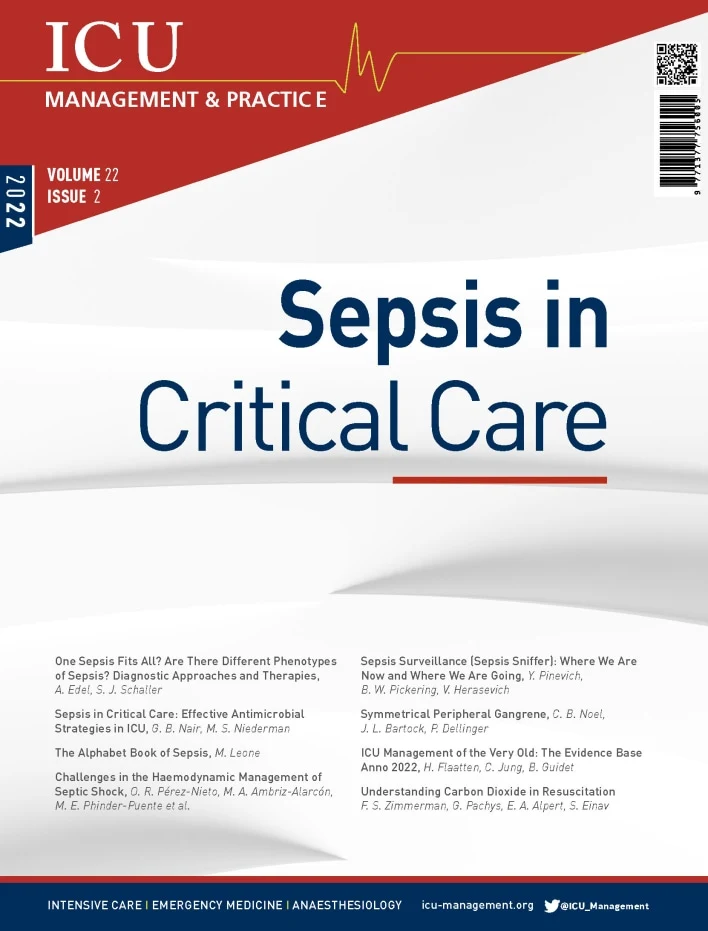
ICU Management & Practice, Volume 22 - Issue 2, 2022
Download PDF |
 |
| PRINT OPTIMISED |
Download PDF |
 |
| SCREEN OPTIMISED |
Editorial
Sepsis in Critical Care
Sepsis is a leading cause of morbidity and mortality in the intensive care unit. Nearly 14 million adults and 2.5 million children survive sepsis each year worldwide. In addition, sepsis survivors are known to experience poor long-term outcomes and often develop functional limitations thereafter. It is thus evident that the long-term impact of sepsis is an issue that must be addressed. The diagnosis of s...
Point-of-View
Septic Shock and Vasopressor Initiation: Why Earlier is Better
An overview of vasopressor management, current evidence and when to initiate vasopressor therapy for best possible patient outcome. Vasopressor management is a cornerstone in the haemodynamic management of septic shock for reversing hypotension by increasing systemic vascular resistance and improving organ perfusion. The Surviving Sepsis Campaign (SSC) guidelines 2021 recommend an initial target mean arte...
Rationale Behind Practice: Landiolol in Critical Care
A summary of data regarding the use of landiolol as a potential immunomodulator in septic patients and its effectiveness and safety in the management of new-onset postoperative atrial fibrillation (POAF). Cardiovascular dysfunction is a common complication of sepsis. Approximately 40 to 50% of patients with prolonged septic shock develop myocardial dysfunction. The changes induced by sepsis in circulating...
Gastric Residual Volume – Monitoring and Management
An overview of critical care guidelines for enteral nutrition (EN) and the use of gastric residual volume (GRV) management and monitoring as an essential component of EN patient care to help prevent complications. Disease-related malnutrition is a common problem among hospitalised patients. Specifically, in critically ill patients, oral food intake may not provide the required nutritional value. This may...
Sepsis in Critical Care
One Sepsis Fits All? Are There Different Phenotypes of Sepsis? Diagnostic Approaches and Therapies
This article presents current research results in relation to an advanced sepsis classification and their implications for new treatment options and research strategies. Through history, the definition and the term sepsis changed. Since Semmelweis and others formulated the thesis that sepsis was caused by a systemic reaction to bacteria (Funk et al. 2009), the pathomechanism was more and more explored. To...
Sepsis in Critical Care: Effective Antimicrobial Strategies in ICU
ICU sepsis is associated with a mortality rate >25%, with nosocomial infection most lethal, and community acquired infection more common. Optimal management requires identification of the site of infection (lung, abdomen and blood stream most commonly), a focus on the likely pathogens based on risk factors for resistance, and provision of timely and accurate therapy in the context of appropriate antimicr...
The Alphabet Book of Sepsis
In this article, the author provides the alphabet review of sepsis and septic shock based on personal clinical experience and choice. Sepsis and septic shock have been defined in 2016 (Singer et al. 2016) and the management of patients is framed by the Surviving Sepsis Campaign guidelines with its renewed version in 2021 (Evans et al. 2021). Using PubMed, around 15,000 hits respond to the word “sepsis�...
Challenges in the Haemodynamic Management of Septic Shock
An overview of the haemodynamic management of patients in septic shock and strategies for detection of haemodynamic changes and appropriate therapeutic action to improve the prognosis of these patients. Sepsis is one of the main causes of admission to the Intensive Care Unit (ICU). It is defined as a life-threatening organ dysfunction, caused by dysregulated host response to infection (Singer et al. 2016)...
Sepsis Surveillance (Sepsis Sniffer): Where We Are Now and Where We Are Going
Timely recognition of sepsis is the foundation of improved patient survival. This article discusses opportunities to improve this in multiple areas and the use of sepsis screening tools to improve surveillance and treatment of sepsis. Sepsis is a critical healthcare problem, associated with high mortality rates, and considerable financial and resource burden. At the end of 2021, new Surviving Sepsis Campa...
Symmetrical Peripheral Gangrene
In this article, the authors describe the presentation, pathophysiology, and potential treatment options for symmetrical peripheral gangrene. Limitations in the current literature and a possible strategy for future study are highlighted. Symmetrical peripheral gangrene (SPG) refers to the development of tissue necrosis in an acral distribution without vasculitis and often without loss of arterial pulses....
Other Feature Articles
ICU Management of the Very Old: The Evidence Base Anno 2022
This overview explores the publications concerning the very old ICU patients since 2011 and with a focus on publications from the VIP network on elderly COVID-19 patients. In 2017, an international group of intensivists with a particular interest for geriatric intensive care published a statement paper (Flaatten et al. 2017). This paper discussed the status of research in the very old critical ill patient...
Understanding Carbon Dioxide in Resuscitation
Peri-arrest CO2 measurement may serve to assess resuscitation efficacy and guide clinical decisions. This paper reviews current knowledge and future research directions for CO2 measurement and clinical application during CPR. CO2 is produced by the mitochondria as a major end product of tissue aerobic respiration. Approximately 70% of CO2 produced by the mitochondria undergoes a chemical reaction with wa...
DigiConf
Sepsis in Critical Care
Sepsis is a leading cause of admission to the ICU and is associated with a high mortality rate. Join our panellists as they discuss the impact of sepsis in critical care, characteristics of patients with sepsis, causative factors, and effective preventive and therapeutic interventions. Moderator Jean-Louis Vincent Editor-in-Chief ICU Management & Practice Professor Department of Intensive Care Erasm...
Agenda
Upcoming events/courses/congresses
APRIL 12 ICU Management & Practice DigiConf Sepsis in Critical Care Virtual Event https://iii.hm/1exj 18-21 51st Critical Care Congress SCCM 2022 Virtual event https://iii.hm/1egu 23-26 32nd ECCMID Lisbon, Portugal https://iii.hm/1egv 27-29 ANZICS/ACCCN Annual Scientific Meeting 2022 Sydney, Australia https://iii.hm/1egw 27-30 12th Congress of the European Pain Federation (EFIC 2022) Dublin, Ire...

















